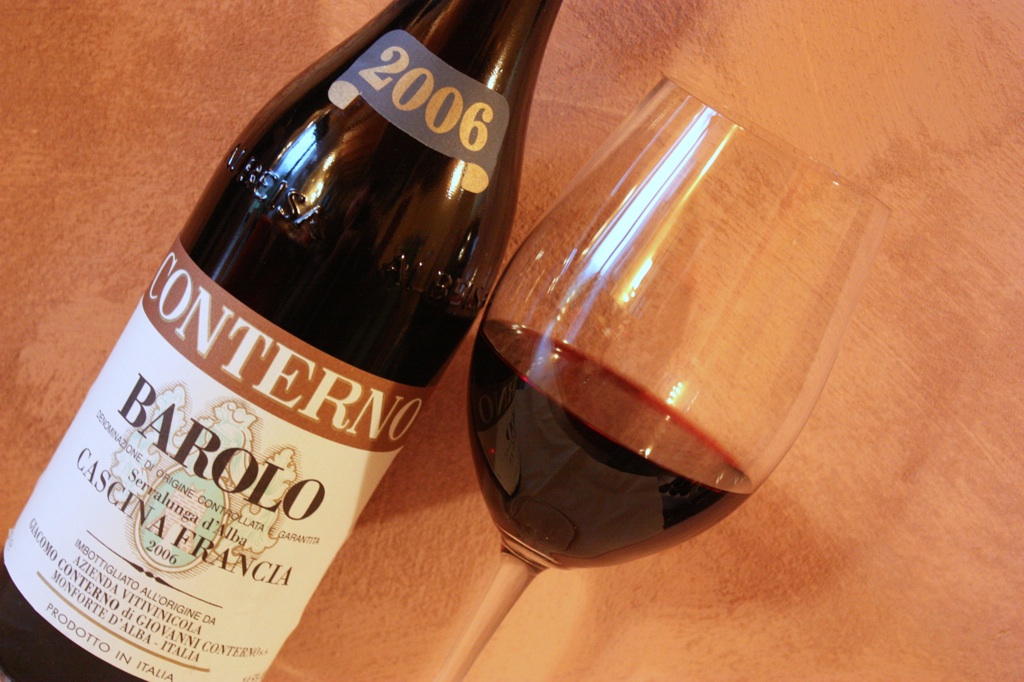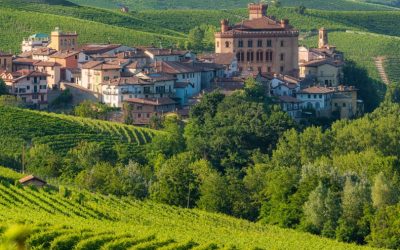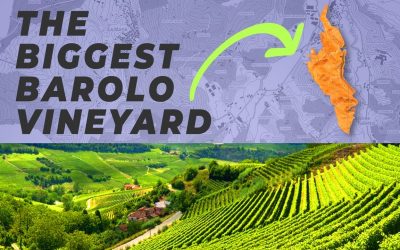Where can I drink Barolo in Italy?
The production area of Barolo wine is composed of 11 towns: Barolo, Castiglione Falletto, Serralunga d’Alba, Cherasco, Diano d’Alba, Grinzane Cavour, La Morra, Monforte d’Alba, Novello, Roddi, and Verduno. Each town gives a unique character to its wines, thanks to diverse terroir factors, including soil composition, climate, and elevation. From La Morra’s elegant and fragrant Barolos to the robust, structured wines of Serralunga d’Alba, each town represents a different face of Barolo.
Where is the Barolo wine region in Italy?
The Barolo wine region is located in the Piedmont region of northwestern Italy, specifically in the Langhe area, southeast of the city of Turin. Nestled among rolling hills, the Barolo region is bordered by the Tanaro River to the north and east, the Bormida di Millesimo River to the south, and the Bormida di Spigno River to the west. It is a region steeped in tradition and recognized for its picturesque landscapes, historical castles, and, of course, its world-class wines. Are you planning a wine tour to Italy? Start from the Barolo travel guide.
Where can I drink Barolo in Italy?
Italy is home to many regions where you can enjoy a glass of Barolo, but the most authentic experience is undoubtedly in Piedmont, the region where this renowned wine is produced. The towns of Barolo, La Morra, Monforte d’Alba, Serralunga d’Alba, and Castiglione Falletto are all part of the Barolo DOCG area, and each boasts numerous wine bars and restaurants where Barolo is a star of the menu. Notable spots include the ‘Enoteca Regionale del Barolo’ in Barolo and ‘Centro Storico’ in Serralunga d’Alba. Visiting these towns provides an unparalleled opportunity to enjoy Barolo in its native setting, paired with local cuisine, and often with breathtaking views of the vineyards where the Nebbiolo grapes grow. A Barolo tasting in Piedmont is more than a simple wine experience – it’s a cultural immersion in one of the world’s most esteemed wine regions. Here are some recommendations:
- Enoteca Regionale del Barolo: Located in the Castle of Barolo, it offers a wide selection of Barolo wines from various producers and vintages.
- Cantina Comunale di La Morra: This community cellar offers tastings of Barolo and other regional wines, with breathtaking views of the vineyards.
- Enoteca Regionale Piemontese Cavour: Situated in the castle of Grinzane Cavour, this enoteca offers tastings of a wide range of Piedmontese wines, including Barolo.
- Local wineries: Most wineries in the 11 towns of the Barolo region offer tours and tastings. Some well-regarded wineries include Giacomo Conterno, Bartolo Mascarello, and Elio Grasso.
Whether you’re tasting Barolo in a vineyard overlooking the hills of Piedmont or savoring a bottle at home, it’s a wine that offers a rich, complex taste of Italy’s winemaking tradition.
THE 10 BEST Barolo Wineries & Vineyards (Updated 2023)

Italy’s Piedmont region, and in particular the Barolo zone, is a paradise for wine lovers. This is the birthplace of the “King of Wines,” the epicenter of some of the world’s finest Nebbiolo productions. The landscape is breathtaking, dotted with vineyards and crowned by the Alpine peaks, and the locals are welcoming, adding charm to the world-class wines. Among the many esteemed producers, a few wineries stand out for their exceptional contributions to the prestige of Barolo.
These include Giacomo Conterno, known for their Barolo Riserva Monfortino, a wine of extraordinary complexity and longevity, and Elio Grasso, a winery that produces finely balanced Barolos full of power and elegance. Then there’s Bartolo Mascarello, a stalwart of traditional winemaking techniques, whose wines are a testament to the finesse and structure that Nebbiolo can achieve. Roberto Voerzio’s dedication to meticulous vineyard practices results in low yields, but wines of incredible quality and aging potential.
The single-vineyard Barolos of Paolo Scavino and Vietti are not only profoundly expressive of their terroir, but also reflect the diversity within the Barolo zone itself. Aldo Conterno’s Bussia vineyard yields rich, intensely flavored Barolos, while Giacosa Fratelli’s classic winemaking approach brings out the inherent elegance of Nebbiolo. The wines from Poderi Luigi Einaudi, one of the oldest wineries in the region, are consistently exceptional, and G.D. Vajra’s offerings showcase both balance and aromatic complexity. These wineries are truly among the best places to experience Barolo in its many splendid forms.
- Giacomo Conterno: Known for their exceptional Barolo Riserva Monfortino, the Giacomo Conterno winery is one of the most iconic in the region. The wines are made in a traditional style that benefits from long aging.
- Elio Grasso: This winery, located in the town of Monforte d’Alba, has a reputation for producing Barolos that balance power and elegance. The Ginestra Casa Maté is particularly notable.
- Bartolo Mascarello: Maintaining traditional winemaking methods, Bartolo Mascarello is recognized for its high-quality, single-vineyard Barolos. The winery is located in the town of Barolo itself.
- Roberto Voerzio: Roberto Voerzio is renowned for his meticulous vineyard practices that result in low yields but high-quality wines. The Barolo Cerequio and Barolo Brunate are acclaimed labels from this winery.
- Paolo Scavino: With an impressive portfolio of single-vineyard Barolos, Paolo Scavino winery in Castiglione Falletto is known for wines that beautifully express their terroir.
- Vietti: Located in Castiglione Falletto, Vietti crafts several single-vineyard Barolos, each with its unique character. Their Barolo Rocche di Castiglione is especially admired.
- Aldo Conterno: The Bussia vineyard of Aldo Conterno, located in Monforte d’Alba, yields some of the most flavorful and intense Barolos, including the famed Granbussia Riserva.
- Giacosa Fratelli: Based in Neive, Giacosa Fratelli is known for its traditional approach to winemaking, producing Barolos that are expressive and capable of aging gracefully.
- Poderi Luigi Einaudi: As one of the oldest wineries in the region, Poderi Luigi Einaudi in Dogliani consistently produces exceptional Barolos, notably the Cannubi and Terlo vineyard designates.
- G.D. Vajra: G.D. Vajra, located in Barolo, is recognized for its balanced and aromatic Barolos. The Bricco delle Viole vineyard is a highlight of their offerings.
Each of these wineries offers a unique expression of Barolo, reflecting the complexity and diversity of this esteemed wine region. Most offer tours and tastings, providing an excellent opportunity for wine lovers to explore the nuances of Barolo in-depth.
Barolo Reserve 2016 Barolo Wine

What are the rules for Barolo?
The production of Barolo is governed by strict regulations to maintain its quality and reputation. According to the rules of the Barolo DOCG (Denomination of Controlled and Guaranteed Origin), Barolo must be made 100% from the Nebbiolo grape variety. The wine must be aged for at least 38 months after the harvest, of which 18 months must be in wooden barrels. For Riserva wines, the aging period is extended to 62 months. Furthermore, the alcohol content must be at least 13% by volume. These rules ensure that every bottle of Barolo lives up to the high expectations associated with its name.
Is Barolo worth visiting?
Barolo is absolutely worth visiting, particularly for wine enthusiasts. This quaint town, with its stunning vineyard landscapes, ancient castles, and world-class wines, offers an unforgettable experience. Visitors can tour numerous wineries and taste some of the best Barolos directly at the source. Besides, the town hosts the Barolo Wine Museum, which offers insight into the region’s wine-making history, and the Castle of Barolo, housing the Regional Wine Shop, where you can sample a vast array of local wines.




